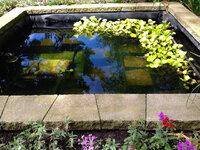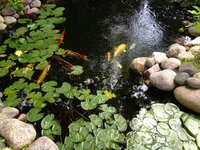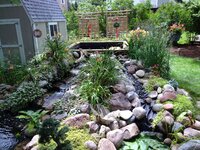Hi all,
I've failed to re-find the Koi video that I watched, but this blog post ("Anoxic filtration system"), has much the same information. This is the filter from above:

And this is the "anoxic" filter in situ.

There is also a skimmer and bead filter.
It is obviously a successful system, but I'm very dubious of how much of that is to do with the anoxic denitrification,
cheers Darrel
I've failed to re-find the Koi video that I watched, but this blog post ("Anoxic filtration system"), has much the same information. This is the filter from above:

But this is the pond:Anoxic filter with some Water hyacinth ( E. crassipes) floating in it. No aquatic plants are in the Biocenosis baskets themselves, they remain bare. For those that say this is a Veggie filter or Bog filter, this is proof that it is not plant dependent at all. The Biocenosis baskets look like they are covered with a sheet of glass it's so clear.

And this is the "anoxic" filter in situ.

There is also a skimmer and bead filter.
It is obviously a successful system, but I'm very dubious of how much of that is to do with the anoxic denitrification,
cheers Darrel
Last edited:





